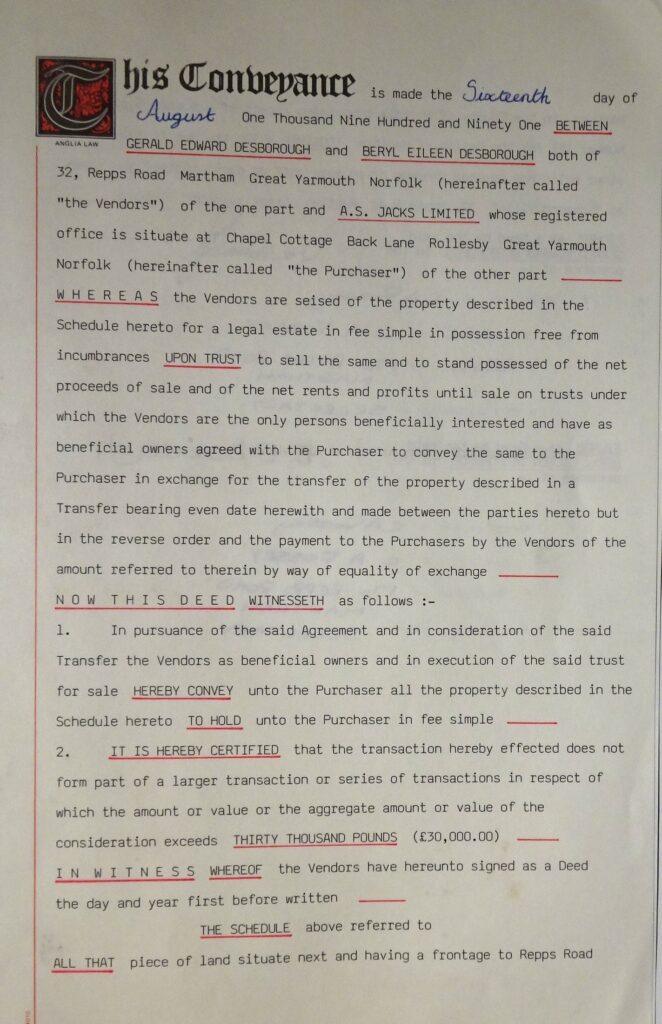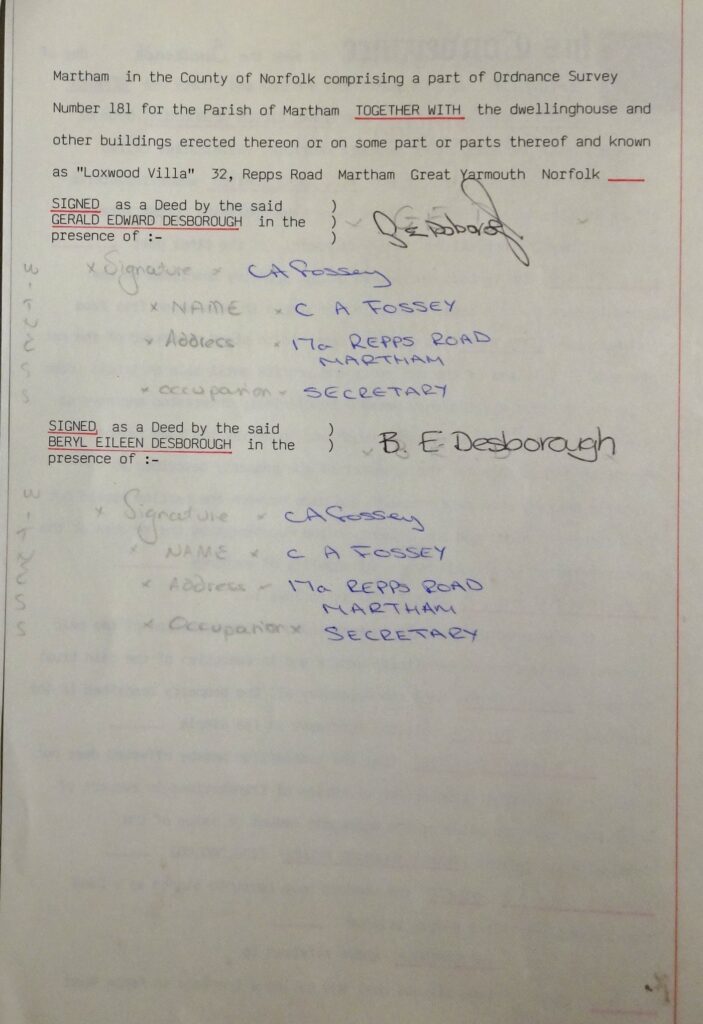Loxwood Villa, 32 Repps Road, Martham (including information about Clamps Close).

Firstly, I would like to thank Ben & Natalie for helping and encouraging me to research the history of their house, without which this page could not have been written. They have a wonderful collection of deeds that together make up one of the most important sets of property documents in the village. The story of Loxwood Villa would have been impossible without them generously agreeing to share the deeds that date back to at least 1792. Two of the early documents, in particular, provide gems from the past that list all the changes of ownership (Abstract of Title) in great detail, going back to before the house was built in 1850/51. We will follow its many owners but perhaps unlike similar properties, it was often let out to tenants for long periods by owners who must have seen it as an investment rather than a home for themselves. Some of the deeds and other documents contain legal words or phrases that are difficult to understand so some of them are explained in Appendix A1.
Clamps Close
According to the house deeds(A2) the land that Loxwood Villa and its near neighbours would eventually be built on was called Clamps Close. The deeds show that as early as April 1792 Clamps Close was owned by Francis Columbine, a merchant from Norwich. There is no record of him ever living at Martham so he was probably just an investor and let or leased the land out for farming. A Thomas Bowgen also seems to have held a small rent charge over the land or may have held a lease from Francis Columbine to farm it.
On 4th/5th April 1792 Francis sold Clamps Close(A2) to John Carrier with Thomas Bowgen retaining his minor interest over the land. In those days, Clamps Close was described as being three acres & twelve perches(A2) in size and was situated between land owned by Diana Creasey on the north side and the King’s Highway (Repps Road) leading from The Green to Repps on the south side. It is outlined in red on the map below. The land belonging to Diana Creasey is shown in purple and Repps Road is in green. Houses are shown in black blocks so Loxwood Villa did not exist in 1812 and Clamps Close was just a field.

John Carrier was described as a yeoman farmer. He lived just behind Manor Farm to the east of Back Lane pond at Carrier’s Farm. He owned several plots of land in the village, one of which was Clamps Close and in addition held (effectively rented) about 21 acres of land owned by the Lord of the Manor.
The tenure of Clamps Close was freehold so it was not listed or subject to the changes brought about by the 1812 Martham Inclosure Award. As a result, you can see that at the time the map was drawn John Carrier’s name appears alone as the owner, whereas the enclosure of land to its north (plot No 218) is listed as being occupied by Diana Creasey from the Manor of Martham being six acres, one rood and thirty perches.
The deeds of Loxwood Villa include an Abstract of Title dated 1822(A2) that confirm this situation and refer to land adjoining and to the north of Clamps Close as being owned at one time by William Creasey (1717-1797), who was a highly successful grocer and draper in Martham. After he died, the land was inherited by his spinster daughter Diana Creasey (1757-1834). The Creasey family was one of a group of prominent 18th/19th century Martham families that included the Risings, Purdys and Robins who lived around the centre of the village. They were business people and landowners who were mostly related by marriage.
On 29th/30th November 1822 John Carrier sold Clamps Close(A2) to Mark Pratt, a glove maker, from Martham for £150. Mark also bought out the minor interest that Thomas Bowgen had over the land for five shillings and became the outright owner without encumbrances. Mark must have done well as a glove maker because he also invested in other land and houses. Mark had married Mary Drake on 18th January 1785 at South Walsham and they had two sons and three daughters. Mark made a Will on 24th November 1824 and left all his estate, including Clamps Close, to his wife Mary. Mark died in 1832 and Mary inherited all his estate(A3).
About nine years passed and then national events caught up with local ones when the first national census was carried out in 1841 and Mary could be found living in a cottage at Black Street. More importantly, Clamps Close was recorded in the 1842 Martham Tithe Award and the map that accompanied the Award was similar to the 1812 map but plots of land were given different numbers and Clamps Close had become plot No 49. It was still owned by Mary but registered in the name of her daughter Elizabeth as Mary was in the twilight of her life. A copy of part of the 1842 Tithe Award map is shown below with plot 49 outlined in red. Note, there were no properties on the land at that time.
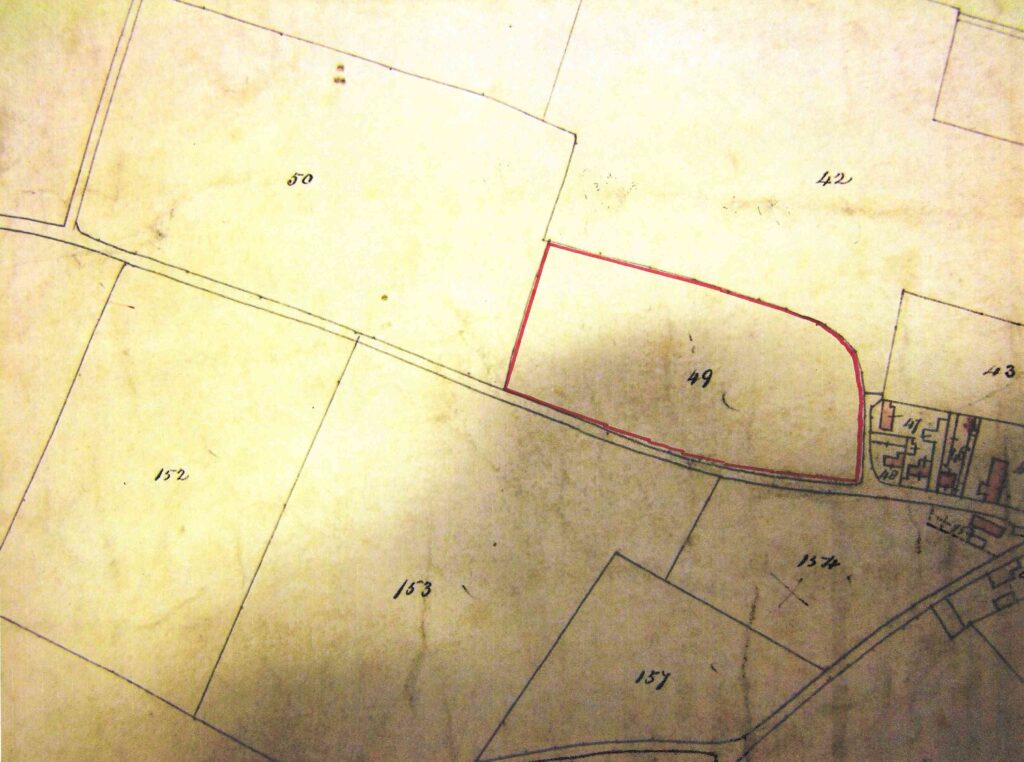
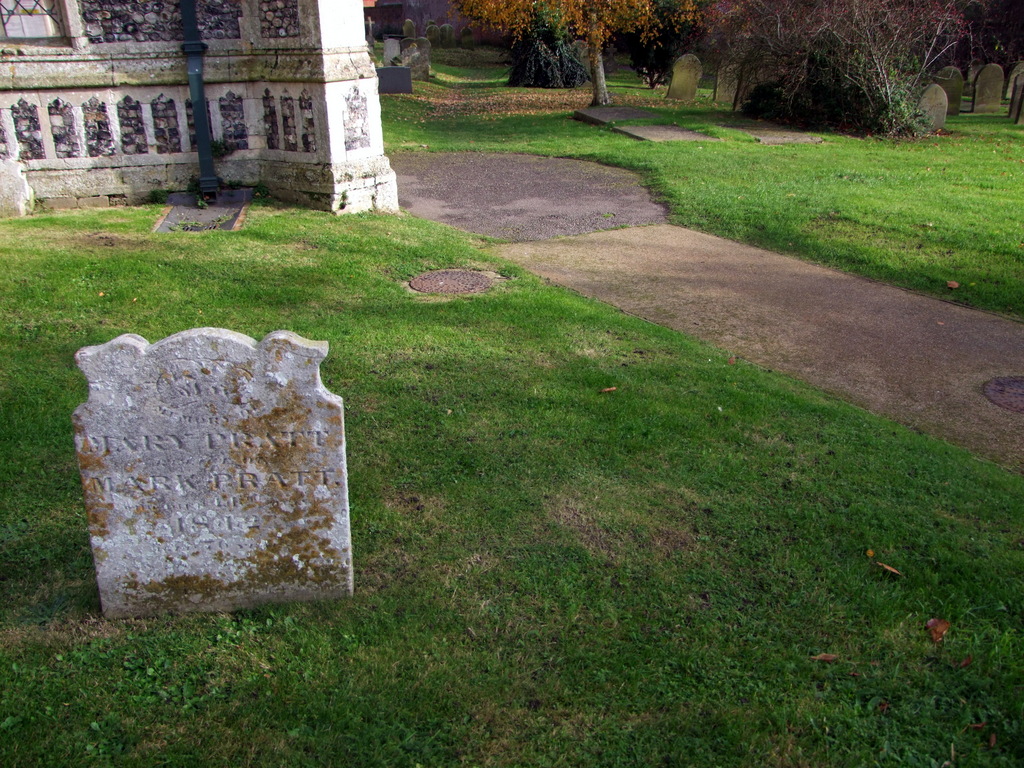
Mary died in July 1842 and she had appointed her two sons, Mark (Jnr) and James, as Executors in her Will. The Will instructed them to sell all her land and properties after she died and the deeds also make it clear that towards the end of her life she had informally agreed to sell Clamps Close to Daniel Manship. As Executors, her sons honoured this arrangement and in selling all their mother’s estate, also completed the sale of Clamps Close to Daniel on 20th December 1843 for £250(A2).
Daniel (1822-1893) came from a well-established family of farmers and landowners in Martham. He was married to Selina, nee Nolloth, and was a tanner as well as a farmer. You can read more about Daniel at Appendix A4. Soon after he purchased Clamps Close, he set about selling off plots of land for development. One of these plots of land was where Loxwood Villa would later be built.
Loxwood Villa
An Indenture(A5) stored with the deeds of Loxwood Villa shows that a plot was carved out of Clamps Close and sold by Daniel Manship to George & Mary Ann Self on 26th December 1849 for £22. The actual wording in the document corroborates everything that had gone before and refers to the new plot as follows:
“That all that parcel of land situate in Martham aforesaid and now in the occupation of the said Daniel Manship containing by survey one rood part of the said Inclosure of Land called Clamps Close (from which the same is staked out and intended to be separated forthwith) abutting on land, formerly of Diana Creasey and late of Thomas Manship, deceased, towards the north; on a piece of land lately sold to the said Charles Braddock of the other part of the said “Clamps Close” towards the east; on the King’s Highway leading from Martham Green to Repps towards the south and on a piece of land part of the said Clamps Close, lately sold to James Braddock towards the west”. (A5).
A later Indenture goes on to say that:
“George Self erected a tenement or dwelling house and the outbuildings thereto upon the said piece of land conveyed to him.”
So, shortly after Christmas 1849 must mean that Loxwood Villa was built in 1850.
Daniel subsequently sold another plot to the east of Loxwood Villa to Charles Braddock for £24. Charles was a plumber, glazier & painter who later built The Wilderness (No30 Repps Road) on it. Under the terms of the sale Charles Braddock was responsible for providing “a good substantial fence separating such piece of land from the piece of land sold to Geo. Self”
Loxwood Villa was built in 1850/51the and its neighbour, The Wilderness, sometime between 1854 and 1860. Despite having different owners The Wilderness was built adjoining Loxwood Villa, only off-set by being slightly further back. It is said that Charles Braddock wanted to maximise the size of the drive at The Wilderness to get his horse and cart through to a stable in the back yard.
Both Loxwood Villa and The Wilderness are totally different in design but are good examples of the transition that was happening in Martham at that time. There are no clean breaks from one style to another in architecture but before this period many of the houses in the village would still have been of a poor structural standard of wattle and daub with thatched roofs occupied mostly by farm workers. More substantial houses surrounded The Green where many of the wealthy people and landowners lived. By the mid 19th century, the growing population was giving rise to demands for additional services which were fulfilled by a more enterprising set of middle-class people. Loxwood Villa seems to represent these subtle changes as it was part of the growth of the village spreading out from The Green along Repps Road which was then the leading highway (although it was only a lane), entering the village from the west. Here we find properties were often occupied by the new self-employed middle classes providing services like brickmakers, cobblers, doctors, painters, plumbers, publicans, tailors and vets etc.
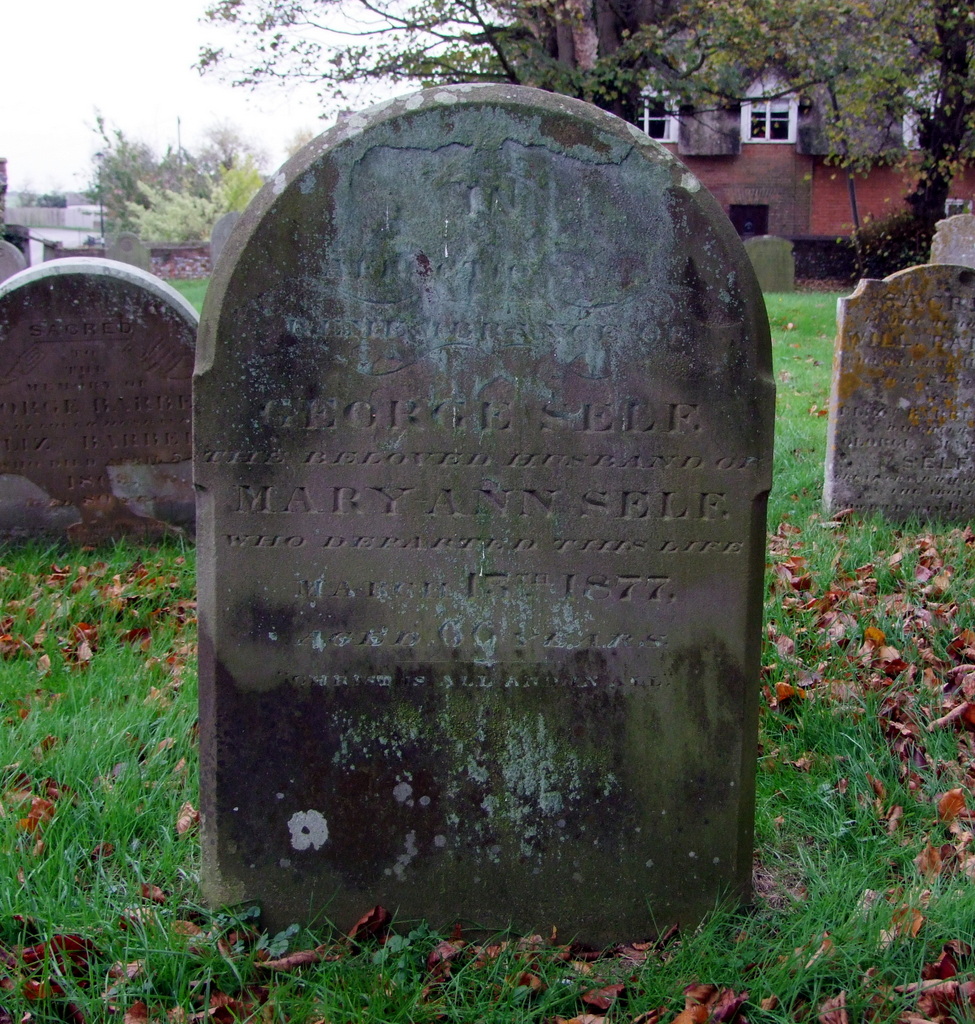
George Self was one of this new breed of property owners being a self-employed plumber, painter and glazier. We have established that he started to have his new house built in 1850 on the plot that was carved out of Clamps Close (although it was not called Loxwood House at that time). The house was not completed or occupied by the time of the 1851 census carried out in April that year and George was recorded as living with his wife at Black Street. He finished his house later in 1851 and consequently, the 1861 census listed George & Mary as living there – see appendix A6. George must have made good use of the outbuildings mentioned in the deeds for his business for many years, although the 1871 census(A6) says he had retired. He had made a Will on 9th November 1869 leaving everything to Mary. George died on 13th March 1877 and was buried at St Mary the Virgin graveyard, section F, plot I3. His gravestone is shown on the left.
So, by March 1877 Mary had inherited Loxwood Villa(A7) and was a widow living alone. She wasted little time in deciding to downsize and on 10th October 1877 sold the house to Thomas George Freeman(A7) who was a leather currier* and merchant from Great Yarmouth. The sale price was £250, including fixtures and the property was freehold. Mary moved to a cottage on the south side of the Village Green. Neither the ‘Agreement(A8) or the supporting Indenture dated 10th October 1877 refer to the property by name as being ‘Loxwood Villa’.
*A currier is a specialist in the leather-processing trade. After the tanning process, the currier applies techniques of dressing, finishing and colouring to a tanned hide to make it strong, flexible and waterproof.
Thomas’ purchase of Loxwood House was an investment as he lived full-time in Great Yarmouth where his business was on Regent Road and his last home was a very large seven-bedroomed and four reception roomed mansion at No12 which once stood next to what is now the Troll Cart PH but has since been demolished.
Proof that Thomas Freeman was letting the property is supported by an advert seeking to let furnished rooms there that appeared in the Yarmouth Independent on 5th July 1879 as shown here:

So, here we have mention, for the first time, of the house being called Loxwood Villa whilst it was in the ownership of Thomas Freeman and occupied by Mr. & Mrs. Dove. I have studied their family backgrounds and there is no clue in either of them to indicate why ‘Loxwood Villa’ was given that name. The Mrs. Dove in the advert was Honor Maria Dove the wife of William so as they were letting rooms and perhaps they thought a named property would be easier to find and would sound posher. At that time the property would not have been numbered so a clearer identity makes sense. They had lived at various addresses in Repps Road before and had also taken in lodgers previously. Loxwood Villa had five bedrooms at that time so it looks as if they were using two for themselves and seeking to let out the other three.
The next record we can look at helps to corroborate the above situation and that is the 1881 census – see appendix A9. Loxwood Villa was not actually named on the return and neither was its next-door neighbour, The Wilderness. We know from the deeds of The Wilderness that Robert Kittle lived there with his grand-daughter Selina Barber. So, using that and the walking order of the census the Doves were still living at Loxwood Villa in 1881.
It is highly likely that William & Maria Dove continued to let rooms from the house but the next recorded activity takes us to the early 1890’s. The 1891 census tells us that the Dove’s had left the property because they were living at Cess, in Martham and the occupiers were Jonathan & Mary Tooke who had five children. Jonathan was a butcher and dealer and they were short-term tenants – see Appendix A10. This was the first time that the property was actually recorded as Loxwood Villa in a census and it must have been let by the Trustees of Thomas Freeman’s estate because he had died on 26th May 1890 and it had not been sold by the time of the April 1891 census. The Trustees were referred to in the deeds and were Theophilus Witter SWINDELL (banker’s clerk) and Charles BRASNELL (gentleman). As part of dealing with the Freeman estate, they sold Loxwood Villa at auction on 14th July 1891 and the highest bidder was James Patrick who paid £236 11s 6d. Below is a copy of the advert for the sale published in the Yarmouth Gazette on 4th July 1891.
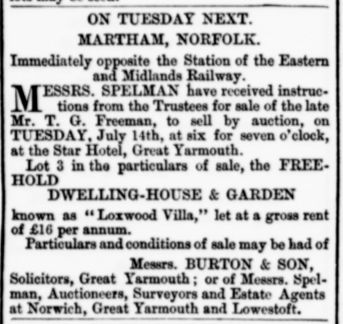
Note: that the Villa was let for only £16 per annum, which is less than 30p per week but was the equivalent of a return of 6.8% p.a. on the purchase price. The fixtures and fittings were sold separately and raised £6 11s 6d as shown below:

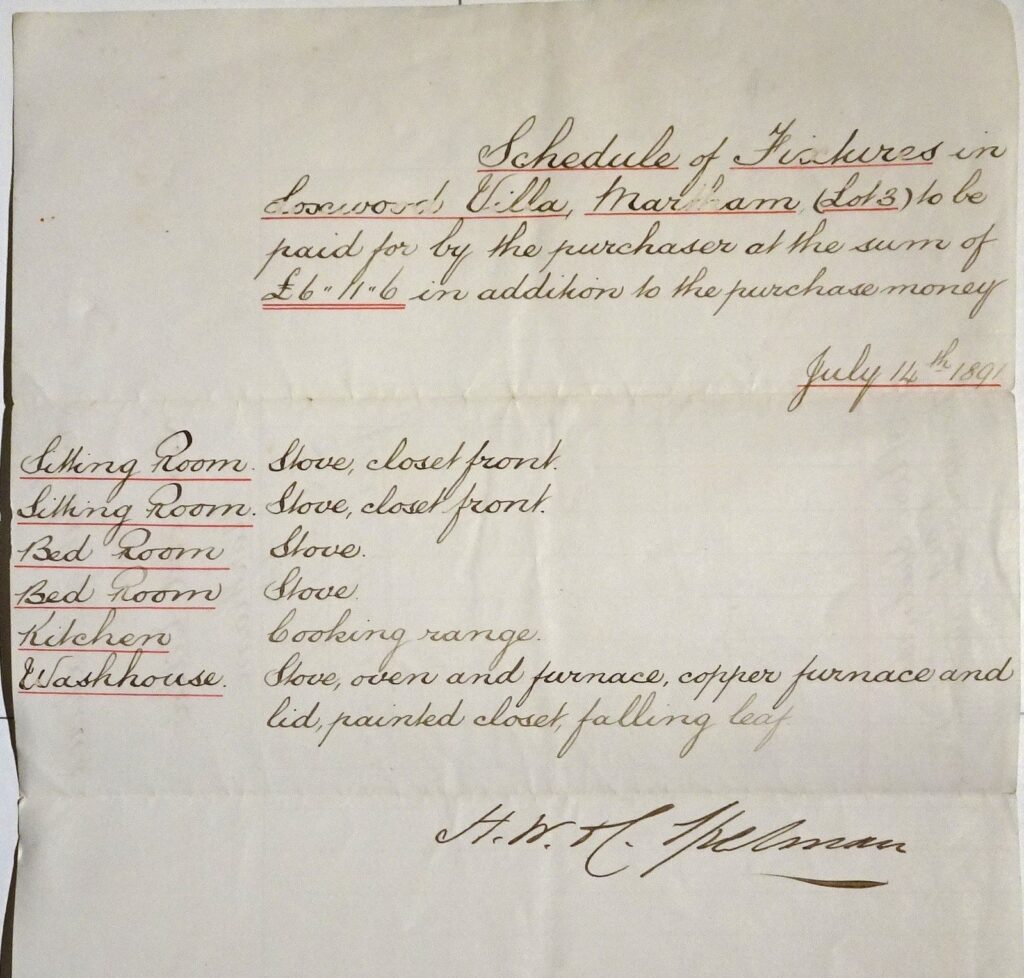
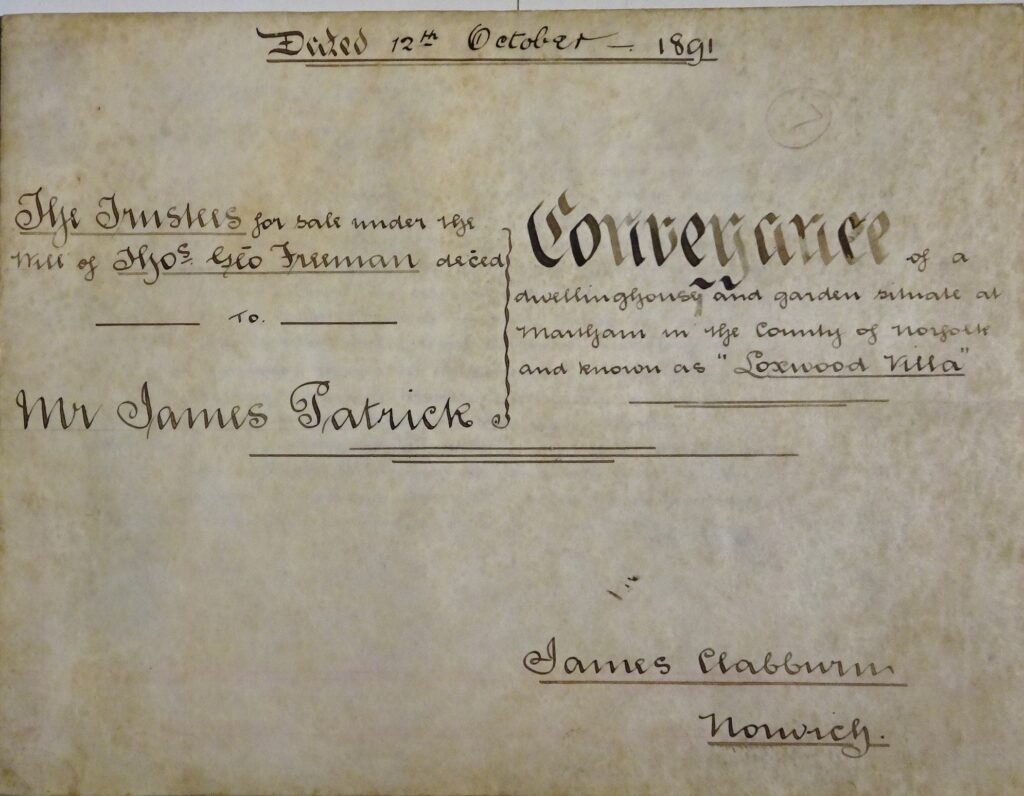
The legal formalities of the sale were completed on 12th October 1891 as shown in an Indenture included as part of the package of deeds for the house. The front page of the Conveyance is shown above. The purchaser was James Patrick of Norwich who was a clerk working for the Post Office. The Indenture confirms that when the sale took place the house was in the occupation of J Tooke and it was called Loxwood Villa.
James Patrick was another investor and there is no record of him ever living at the property. It is not known how long Jonathan Tooke was his tenant but he had left by 1900 when another advert appeared in the Eastern Daily Press on 21st August 1900 seeking a new tenant and it provides a good description of the house, its rooms and facilities at that time. Applications were invited to Mr. J. Patrick, Post Office, Watton, Norfolk, so he was still the owner.
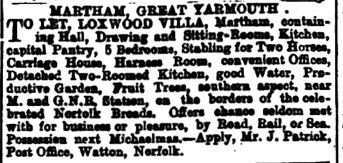
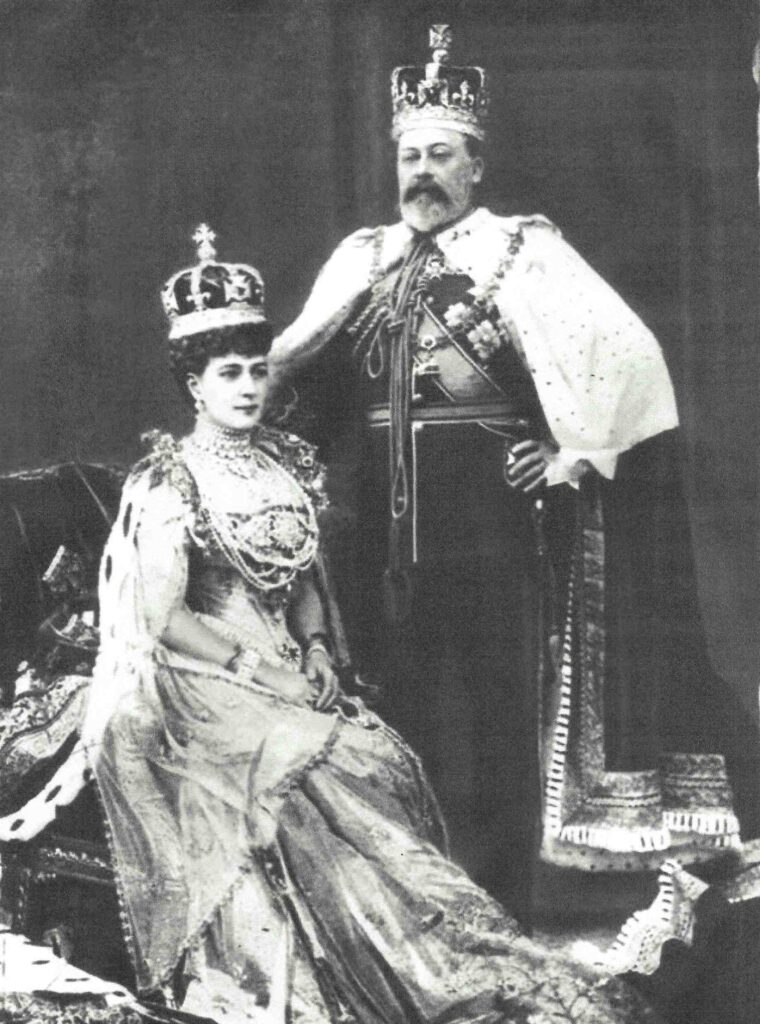
The Norfolk Weekly Standard newspaper briefly reported, on 18th October 1902, that during the quarter ending 29th September 1902, a Mr J Smythe left Loxwood Villa so he may have been the tenant that moved in at the end of August 1900 – see Appendix A11. We don’t know who the new tenant was, but it seems they took a full part in community events because there was a report in the Eastern Daily Press on 16th August 1902 giving details of how villages had been celebrating the Coronation of Edward VII and Queen Alexandra. It described the efforts made to decorate Martham and referred to Loxwood Villa as follows:
“Perhaps, however, no part of the village looked prettier than Repps Road. Loxwood Villa had two arches extended the full length of the front, the top one being composed of Chinese lanterns and fairy lamps, and the lower one of flags and bunting. On the front was a large illuminated star with shield and crown below, and the trees and shrubs in front were thickly studded with fairy lamps.” See Appendix A12.
On 25th March 1905 Lockwood Villa was mortgaged by James Patrick in the sum of £200 when he borrowed the money from the Misses Jane Sarah ENGLISH & her sister Bessie ENGLISH. The sisters lived at Penge in Kent and interest on the loan was 4.5% with Loxwood Villa being the surety. It is not known why he wanted to borrow the money; he had retired from the Post Office and was living at Little Cressingham . It seems apparent that he had a relationship with a widow called Emily Mary HOGGETT. Emily had become a widow when her first husband, Herbert Hoggett, died in 1900; she lived with her brother at the White Horse PH at Little Cressingham We don’t know why James borrowed the £200; it seems an odd transaction because it was designed to be a short-term loan but perhaps circumstances changed because James made a Will on 11th November 1905 and died the following day. He left Loxwood Villa to Emily but the loan (mortgage) was still owing and she paid it off, including the interest. James and Emily never married and were not otherwise related.
The deeds have several documents concerning these transactions and one is a letter exchanged between the solicitors dealing with the matter, dated 30th July 1906 that says that Loxwood Villa was occupied at the time by Henry Alcock. This is important because, as we will see further on, Henry and his family lived there for many years. The letter also says that Henry was paying £18 per annum for the house, stable and workshops which was to Emily Hoggett the new owner.
From about 1906 Henry William Alcock (1863-1925), his wife Sarah (1865-1947) and their many children lived at the property. They remained at Loxwood Villa for the rest of their lives. Henry worked from home as a self-employed plumber and painting contractor. The stable, workshop and outbuildings were probably used by him as part of his business. You can read full details about Henry and his family at Appendix A13.
After Henry & Sarah died, in 1925 & 1947 respectively, four of their children continued to live at Loxwood Villa and also died there. The siblings were: Albert died 1948, Thomas died 1963, Herbert died 1971 & Elsie who died in1975.
During the whole of the time that the Alcock’s were renting Loxwood Villa it was owned by Emily Hoggett. She married Abraham Sutton, her second husband, in 1937 so the name Emily Sutton appears in the deeds of the house. Emily mortgaged Loxwood Villa in February 1932 with the National Provincial Bank. The deeds don’t say how much she borrowed or the reason for it but she had just turned 60 so perhaps she borrowed the money to provide for a more comfortable retirement. On 8th December 1948 she made a Will in which she named her husband, Abraham, and married daughter Elsie Mary Howe as Executors. Emily died on 13th November 1957 and her Executors proceeded to sell Loxwood Villa and pay off the mortgage as part of their duties in dealing with Emily’s estate.
The next owner was none other than Elsie Clara Alcock, the daughter of Henry & Sarah Alcock, the long term sitting tenants. Elsie purchased the property for £700 out of Emily Sutton’s estate on 22nd February 1958 which is why she and her siblings were able to live in the house seamlessly for the rest of their lives.
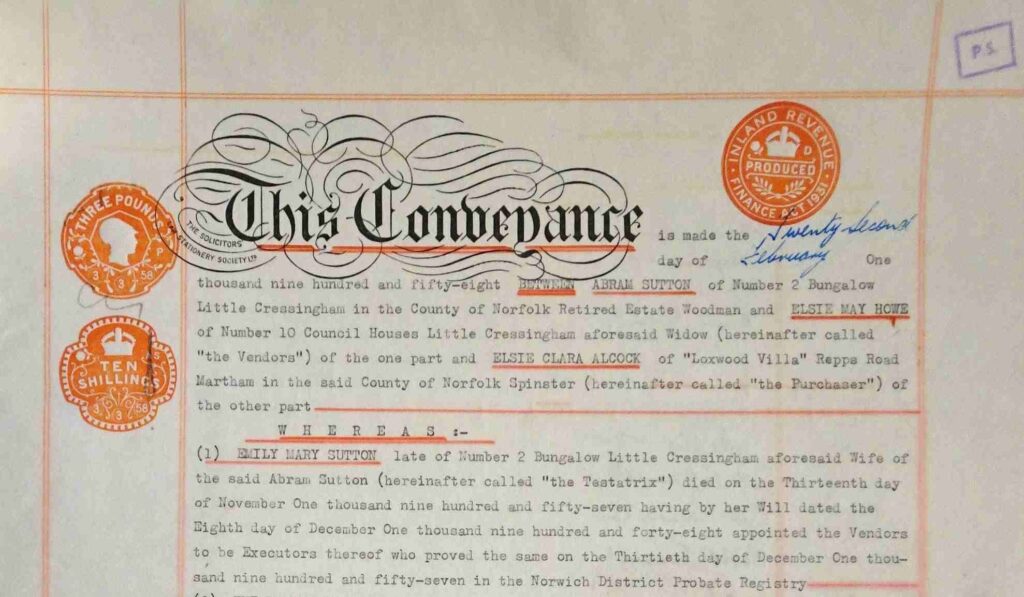
In summary, therefore this long period from 1905 to 1975 had seen Loxwood Villa:-
- Owned by Emily Hoggett/Sutton from 1905 to 1957.
- Rented by the Alcock family from about 1906 to 1957.
- Owned by Elsie Clara Alcock from 1958 to 1975.
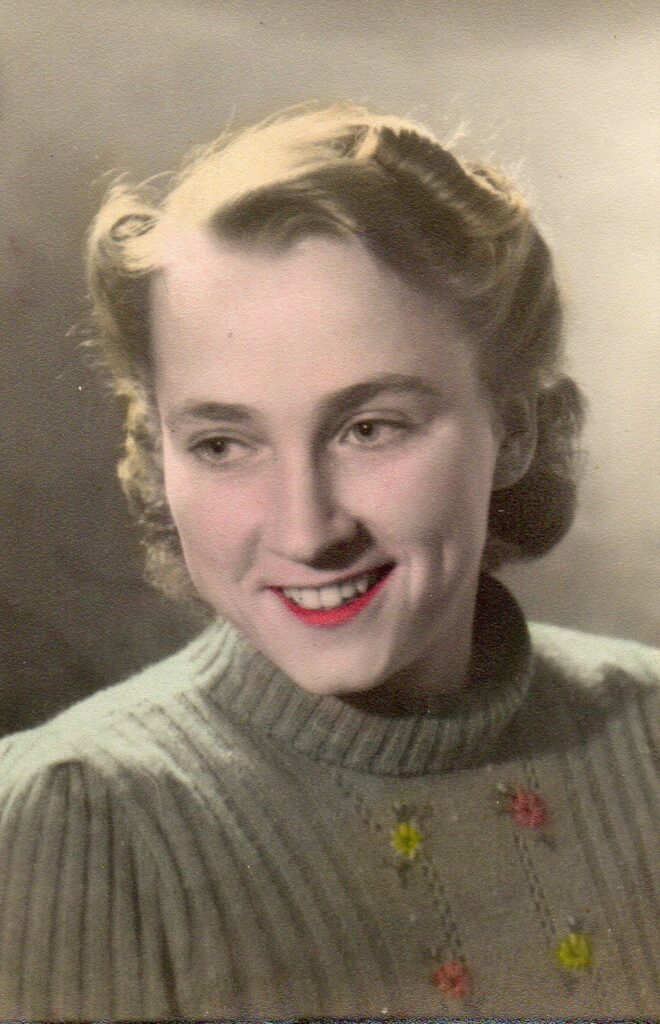
Elsie Alcock never married and died on 20th September 1975. The Executor of her estate was her sister-in-law, Phoebe Eleanor Alcock, and as part of dealing with Elsie’s estate she sold Loxwood Villa to Mrs Cicely Eva Ann Tyson on 7th January 1976 – see Appendix A14. Cicely – shown left – was a widow and lived at Church Farm, Hemsby. She only owned the house for about a year and sold it to David Frederick Hewitt (1937-2021) on 18th January 1977. It is impossible to know what was happening in her life at the time to buy a house, never live in it and then sell it a year later. See Appendix A15.
Little is known about David Hewitt other than at the time he purchased the house he lived in Victoria Road, Great Yarmouth. Locals remember him living there with his wife Jill in 1977/78 and recall the modernisation that took place. The house deeds show that he obtained Planning Permission for works on 11th January 1978 and carried out alterations and extensions and built a new garage. It is thought that he added the large bay windows at the front as well. The house was 128 years old at this time and probably needed an uplift and the work may have resulted in the removal of most of its original 19th-century features.
The next change of ownership was when David Hewitt sold the house to Gerald Edward Desborough & his wife Beryl Eileen, nee Francis, on 26th November 1982. The Desboroughs didn’t move far as they were living at Hamilton Walk on the Marlborough Green estate before moving into Loxwood Villa. See Appendix A16. The house remained in their hands for about nine years during which time it was a real family home as they had four children, two of which were born whilst they lived there.
In 1991 the Desboroughs wanted to move to a bigger house and 47 Staithe Road, Martham was new and fitted the bill. It had been built by A. S. Jacks Ltd., of Rollesby that was, in fact, mainly a one-man business owned and run by Alan David Stewart-Jacks. He worked on his own, completing projects and he built houses in several villages around Rollesby, including Martham, Winterton, Hemsby and Thurne. He must have seen the potential for modernising Loxwood Villa further and agreed a part-exchange swap with the Desboroughs. Thus, Mr Stewart-Jacks became the owner of Loxwood Villa on 16th August 1991 – see Appendix A17.
Mr Stewart-Jacks carried out further modernisation to the house and then sold it to Richard & Janice Turner on 25th February 1992. The house became a family home again and remains so under the guardianship of the current owners who purchased it from the Turners on 6th February 2025.
Appendices Index
A1 – Explanation of some 19th-century legal terms.
A3 – Click here to go to a separate page that gives details about Mark & Mary Pratt.
A5 – Transcription of Indenture dated 26.12.1849 for Daniel Manship’s ownership of Clamps Close.
A6 – 1861 & 1871 census forms showing George & Mary Self at Repps Road.
A7 – Transcription of Abstract of Title for Loxwood Villa dated 10.10.1877.
A8 – Agreement for the sale between Mary Self and Thomas George Freeman.
A10 – 1891 census return for Loxwood Villa when the Tooke family rented the house.
A15 – Conveyance from Cicely Eva Ann Tyson to David Frederick Hewitt dated 18th January 1977.
A16 – Conveyance from David Frederick Hewitt to Gerald & Beryl Desborough dated 26th November 1982.
Appendix A1 – Explanation of some 19th-century legal terms.
An Abstract of Title is a chronological list describing the contents of all the title deeds relating to a property. They were normally drawn up by lawyers when the property was being sold, in order to prove the seller’s title. Abstracts of Title first appeared around the beginning of the eighteenth century.
Alien or Aliened. The phrase “Hath granted, bargained, sold, aliened, released” typically appears in conveyance documents and signifies a series of actions taken to transfer ownership or rights to another person or persons.
- Grant: To bestow or transfer ownership or possession.
- Bargain: To negotiate or agree terms.
- Sell: To dispose of property for a price.
- Alien: To transfer ownership of land or property.
- Release: To relinquish rights or obligations – see below.
Dirum Limon. This is an obsolete legal term meaning in Latin ‘by a stronger argument; with even stronger reason; in fortification, by me or from me’. This phrase was sometimes used to describe a feudal relationship.
Dower was a legal right for a widow to have a life interest in a portion (typically one-third) of her husband’s estate after his death. Today, dower rights have largely been replaced by more gender-neutral estate laws.
Party of the 1st, 2nd 3rd or 4th Part. The reference to each ‘Party’ in a property Deed or Abstract of Title was used to avoid repetitively naming individuals in the transaction and helped to ensure clarity of the contract. The 1st Party was normally the seller (but not always). The 2nd Party was normally the buyer. The 3rd or 4th Party referred to a person or persons who had a legal interest in the contract and may include a successor or mortgage holder or someone with a rent charge over the land. The terms were frequently used in the past but have given way to plain English in modern times, with ‘seller’ or ‘vendor’ and ‘buyer’ or ‘purchaser’ now being preferred.
Release. In a property deed, the term ‘Release’ refers to a legal document that removes a previous claim on an asset, such as a mortgage. It is used to formalise the transfer of the full title to a property or the release of a party from certain obligations upon the fulfilment of specific conditions. This document is crucial in property transactions as it ensures a clean transfer of ownership and provides peace of mind for both buyers and sellers.
Appendix A2 – Transcription of Abstract of Title of Daniel Manship to an Inclosure of land at Martham in Norfolk called Clamps Close.
Summary:
This Abstract of Title provides the history of the owners of just over 3 acres of land known as Clamps Close that was on the north side of Repps Road, Martham. It covers the years from 1792 to 1843. It does not refer to the plot where Loxwood Villa was subsequently built because that was sold later as one of five parcels of land making up the whole of Clamps Close.
Before April 1792 Clamps Close had been owned by Francis Columbine, a merchant, who lived at Norwich and was probably just an investor and let the land for farming. A Thomas Bowgen also seems to have held a small rent charge over the land.
On 4th/5th April 1792 Francis Columbine and Thomas Bowgen sold Clamps Close to John Carrier.
John Carrier owned Clamps Close at the time of the 1812 Inclosure Award.
On 29th/30th November 1822 John Carrier sold Clamps Close to Mark Pratt, a glove maker, from Martham.
Mark Pratt Snr. died in 1832 and left the whole of his estate to his wife Mary.
Mary Pratt died during July 1842 and by her Will had instructed her two Executors, who were her sons Mark & James Pratt, to sell all her property and land that included Clamps Close.
5th/6th April 1792. Indentures of Lease and Release. The release made between Francis Columbine, merchant, of the one part and the said John Carrier and the said Thomas Bowgen of the other part.
16th April 1792. Indentures made between the said John Carrier and Thomas Bowgen of the one part and John Bowgen and John Boardman, Gentleman, of the other part.
6th September 1792. Indenture made between the said Francis Columbine of the first part, John Ellis, gentleman, of the second part and the said John Carrier of the third part.
11th July 1816. Indenture made between John Green, gentleman, Executor of the said John Boardman of the first part, the said John Carrier of the second part and Nathaniel Palmer(1), gentleman, of the third part.
Lease executed by John Carrier and Thomas Bowgen and attested and Release by John Carrier, Thomas Bowgen and Mark Pratt and attested and receipt for £150 consideration money under signed ? and attested.
29th & 30th November 1822. By Indentures of Lease and Release so dated, the release made between John Carrier of Martham aforesaid, Yeoman, of the first part, Thomas Bowgen, formerly of Martham and then of Great Yarmouth in Norfolk, merchant, of the second part, Mark Pratt of Martham aforesaid, a glove maker, of the third party, and Robert Porter of the same place, farmer, of the fourth part.
It is witnessed that in consideration of £150 paid by the said Mark Pratt to John Carrier and of 5/- paid by the said Mark Pratt to the said Thomas Bowgen, the said John Carrier did grant, bargain, sell, alien(1), release and confirm unto the said Thomas Bowgen at the request of the said John Carrier testator. He did bargain, sell, alien(1) and release unto the said Mark Pratt in his actual possession to his heirs all that Inclosure of land called “Clamps Close” consisting of 13 acres, 12 perches, be the same more or less lying in Martham aforesaid situated between land formerly owned by William Creasey Esquire and then Diana Creasey (his daughter) on the north part of the King’s Highway leading from Martham Green to Repps, and on the south part abutting upon the King’s Highway leading from Martham Green to the said land formerly of the said William Creasey and then of the said Diana Creasey towards the land formerly of Benjamin Bell, then of Charles Pollard towards the west then in the occupation of John Carrier. Or however otherwise* to which premises (with a hereditament) by certain Indentures of Lease or Release dated respectively the 4th/5th days of April 1792. The release made between Francis Columbine the younger, merchant, of the one part and the said John Carrier (therein called John Carver the younger) and Thomas Bowgen of the second part were conveyed unto the said John Carrier and his heirs to the use of the said John Carrier and Thomas Bowgen and the heirs and assigns of the said John Carrier forever in trust as to the estate of the Thomas Bowgen for him the said John Carrier his heirs and assigns.
And all easements etc
And the revision etc
And all the Estate etc
To hold unto the said Mark Pratt and his heirs to the use of such person or persons for such estate or estates, with or without ? trusts and for such ends, interests and purposes and under and subject to such powers, provisions, conditions dirum limon(2) and agreements as the said Mark Pratt at any time or times from time to time by any Deed or Deeds to be sealed and delivered by him in the presence of, and to be attested by one or more credible witness or witnesses should direct, limit or appoint under default of such dirum limon(2), or apportionment in the meantime subject thereto.
To the use of the said Mark Pratt and his assigns for life.
To the use of the said Robert Porter, his heirs and assigns during the natural life of the said Mark Pratt upon trust for him and his assigns.
To the use of the said Mark Pratt his heirs and assigns forever.
The said John Carrier covenants that he had a good right to convey for quiet enjoyment free from incumbrances (except in respect of any satisfied mortgage term or terms which had been assigned to a Trustee to attend the inheritance of the said, thereby granted land and which it was thereby declared should so far as the same related to such land thereafter remain to the use of the said Mark Pratt, his heirs and assigns). And, for further assurance and to produce the Deeds and ? in the schedule hereunder written and delivered upon thereof. The schedule referred to by the above Abstract Indenture of Release.
24th November 1824 The said Mark Pratt by his Will of this date gave, devised and bequeathed to his wife Mary Pratt all that his freehold piece of land containing by estimate 3 acres situate lying and being at Martham aforesaid. To hold the said piece of freehold land unto his said wife Mary Pratt there aforesaid forever and appointed the said Mary Pratt, his wife, sole executrix of his said Will signed by the said Mark Pratt and attested by three witnesses and proved in the Court of the Dean and Chapter of Norwich by the said Mary Pratt sole executrix on 25th October 1832.
9th October 1833. The said Mary Pratt described as of Martham, aforesaid widow by her Will of this date appointed Mark Pratt of Great Yarmouth in the County of Norfolk, leather cutter, and James Pratt of the same place, clerk, her two sons as Executors of her Will and authorised and empowered, ordained and directed her said Executors and the servants of them, or their, or his Executors or administrators as soon as conveniently could be after her decease to make sale and absolutely dispose of all and every one of her messages, lands, tenanted cottage grounds there described whatsoever as well as freehold or copyhold or of any such tenure or nature whatsoever and the same were situated in Great Britain by public or private auction sales for the most money that could be obtained for the same and to bargain, convey and assure the said hereditaments and premises to the respective purchaser or purchasers thereof his, her or their heirs or assigns or as he, she or they should direct and to receive the consideration for the same and sign and give, profer and sufficient relief and discharge for the same purchase money and the said testatrix Will was and she thereby declared that the purchaser or purchasers of the said hereditaments and premises or any part thereof should not after said receipt or receipts should be given or obtained to see application of the same purchase money or be answerable or accountable for the misapplication or nonapplication of the same or any part thereof.
Signed by the said testatrix and attested by three subsequent witnesses and proved in the Court of the Dean and Chapter of Norwich by James Pratt her son , one of the Executors on 14th September 1842 and also by Mark Pratt on the 30th November 1843.
20th December 1843. By Indenture so dated and made between the said Mark Pratt and James Pratt of the 1st part, of the said Mark Pratt of the 2nd part and Daniel Manship of Martham aforesaid famer the 3rd part.
Reciting the before abstract Will of the said Mark Pratt (Snr.) deceased, his death and probate of his said Will.
And, the before abstract Will of the said Mary Pratt, her death and probate of her said Will.
And, reciting that the said Mark Pratt and James Pratt in pursuance of the powers given to them by the said therein specified Will of the said Mary Pratt lately contracted with the said Daniel Manship for the sale to him of the said Inclosure of Land thereafter described, then gained, and sold free from encumbrances (except Land Tax) for £250 being the best price that could be obtained for the same and the said Daniel Manship had requested that the said heirs convey the land thereafter mentioned.
And, reciting that the said Mark Pratt was the eldest son at law of the said Mark Pratt and the testator Mary Pratt and had as such agreed and concurred the new abstract Indenture for the purpose of more effectively conveying and assigning the said Inclosure of Land there in the means therein mentioned.
(1) Nathaniel Palmer was a Gentleman and Solicitor at Great Yarmouth. He was also one of the General Commissioners appointed under the Martham Inclosure Act of 1807 the Award of which was published on 12th June 1812.
Appendix A3 – Click here to go to a separate page that gives details about Mark & Mary Pratt.
Appendix A5 – Transcription of Indenture dated 26.12.1849 for Daniel Manship’s ownership of Clamps Close.
This Indenture was made on 26th December 1849 between Daniel Manship of Martham in the County of the said County, gentleman, of the 3rd part and Charles Braddock (1811-1851) of Martham aforesaid, cooper, of the 4th part. Whereas by a certain statutory Indenture of Release dated 12th December 1843 and made between Mark Pratt & James Pratt of the 1st part, the said Mark Pratt of the 2nd part and the said Daniel Manship of the 3rd part, an Inclosure of Land called “Clamps Close” of which the piece of land hereinafter appointed forms a parcel conveyed and assured unto the said Daniel Manship and his heirs to the use of such person or persons for such estate or estates, interest or interests upon such trust and for such interests and purposes and with under and subject to such powers, provisions, conditions, limitations, declarations and agreements as the said Daniel Manship at any time or times and from time to time by any Deed or Deeds legally executed by him should direct, limit or appoint and in default of such direction, limitation or appointment, so far as any such if incomplete, should not extend to the use of the said Daniel Manship, his heirs and assigns forever.
And, whereas the said Daniel Manship users and in a manner hereinafter appearing. Now this Indenture Witnesseth that in pursuance of the said recited agreement and in consideration of the sum of £22 sterling to the said Daniel Manship at or before the execution of these freesales paid by the said George Self the receipt whereof the said Daniel Manship doth hereby acknowledge and thereof and therefrom doth hereby acquit and discharge the said George Self his heir and executors, administrators and every other power and authority in otherwise enabling him in this behalf doth by this Deed, legally executed by him, direct or appoint. That all that parcel of land situate in Martham aforesaid and now in the occupation of the said Daniel Manship containing by survey one rood part of the said Inclosure of Land called the Clamps Close (from which the same is staked out and intended to be separated forthwith) abutting on land, formerly of Diana Creasey and late of Thomas Manship, deceased, towards the north on a piece of land lately sold to the said Charles Braddock of the other part of the said “Clamps Close” towards the east, on the King’s Highway leading from Martham Green to Repps towards the south and on a piece of land part of the said Clamps Close, lately sold to James Braddock towards the west. And all and every of the easements, liberties, ways, paths, passages, rights, members and appurtenances whatsoever to the said appointed piece of land belonging. And the Revision and Revisions, Remainder and Remainders, rents, issues and forfeits thereof shall henceforth remain, continue and be to the use of such person or persons, for such estate or estates or interests upon and for such trusts, interests and purposes as the said George Self at any time or times by any Deed or Deeds legally executed by him shall direct or appoint.
And in default of and until such direction or apportionment and so far as any such if complete shall not extend to the use of the said George Self and his assigns during the term of his life and from and after the determinations of that Estate by any means. To the use of the said Robert Davis Barber and his heirs during the natural life of the said George Self upon trust for him and his assigns and from and after the determinations of that Estate to the use of the said George Self, his heirs and assigns for ever.
And the said George Self doth hereby expressly declare that no wife of him the said George Self who shall survive him shall be entitled to any Dower to or in the said hereditaments hereby appointed.
And the said Daniel Manship doth hereby for himself his heirs and his assigns, covenant with the said George Self his appointees, heirs and assigns that notwithstanding any act, deed, matter or thing whatsoever done, executed or suffered to the contrary by him, the said Daniel Manship, he the said Daniel Manship now hath himself full powers by these ? to limit and appoint the hereditaments hereby appointed to the uses and in the manner aforesaid.
And that the same hereditaments shall at all times hereafter remain and be to the use and for the purposes herein before declared thereof and be peaceably held and enjoyed and the rents thereof received accordingly without any lawful let, suit, underwritten or denial whatsoever by him, the said Daniel Manship or any other person or persons claiming by, under or in trust for him.
And that free, clear and discharged from all former estate, bills, troubles, charges and incumbrances whatsoever had made occasioned or suffered by him the said Daniel Manship or any person or persons claiming by, under or in trust for him.
And that the said Daniel Manship and all other persons having or lawfully or equitably claimed either now or hereafter any Estate, right, title, charge or interest in or to the said hereditaments hereby appointed by, under or interest for him shall and will at all times hereinafter at the request and charge of the said George Self, his appointees, heirs and assigns make, do and execute all such further Acts, Deeds, conveyances and assurances in the law whatsoever for the more effective appointing and assuring the same hereditaments to the uses and in manners aforesaid as by the said George Self his appointees, heirs or assigns shall be delivered and required.
And the said George Self doth hereby for himself and his heirs and assigns, covenant with the said Daniel Manship, his appointees, heirs and assigns, that he, the said George Self, his appointees, heirs and assigns, shall and will thereunto as requested by the said James Braddock as the purchaser of the said piece of land to the west of and adjoining the hereby appointed piece of Land, his appointees, heirs or assigns, erect and make on the land hereby appointed piece of land at the expense of him the said George Self, his appointees, heirs and assigns a good and substantial fence separating such piece of land from the said piece of land so sold to the said James Braddock as aforesaid and shall, will and at all times thereafter at the like request keep such fences in good and substantial repair.
And the said Charles Braddock doth hereby for himself, his heirs, appointees and assigns covenant with the said George Self, his heirs, appointees, heirs and assigns that he, the said Charles Braddock, his heirs and Executors, administrators and assigns shall and will at all times hereinafter, unless prevented by fire or other inevitable accident at the request and expense of the said George Self his appointees, heirs or assigns and shew forth in England and not elsewhere unto him or them or his or their Attorney, Solicitor or Agent or to or before any Court of Law or Equity or otherwise as occasion shall require the Indentures mentioned in the schedule hereunder.
Written for support of the Title to the hereditaments hereby appointed and also at the like request and expense make and deliver to him or them attested or other copies or extracts from the same Indenture. In Witness whereof the said parties hereto have hereunto set their hands and seals the day and year first above written.
Schedule above referred to:
29th & 30th November 1822 Indentures of Lease and Release. The Release made between John Carrier of the 1st part, Thomas Bowgen of the 2nd part, Mark Pratt of the 3rd part and Robert Porter of the 4th part.
30th December 1843 Indenture of Release hereinbefore recited. The signatures and seals of Daniel Manship, George Self and Charles Braddock were recorded here.
Appendix A6 – 1861 & 1871 census forms showing George & Mary Self at Repps Road.
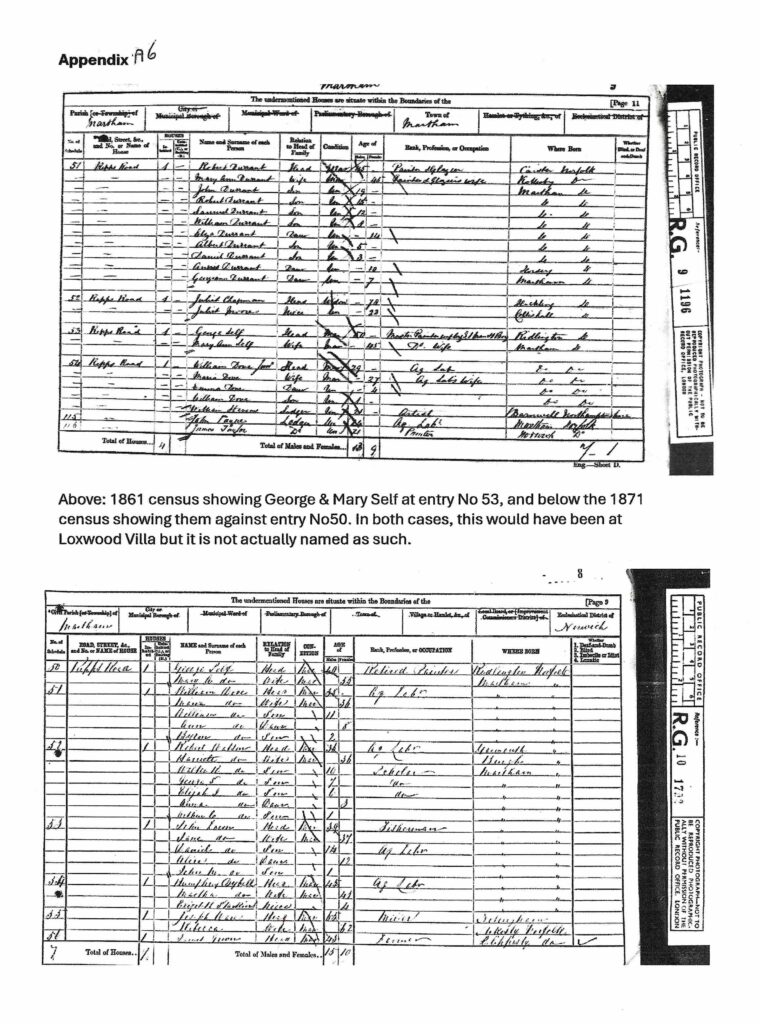
Appendix A7 – Transcription of Abstract of Title for Loxwood Villa dated 10.10.1877.
Abstract of Title to a dwelling house and garden known as Loxwood Villa situated at Martham in Norfolk.
10th October 1877
Indenture so dated made between Mary Ann Self of Martham in the County of Norfolk, widow, of the one part and Thomas George Freeman of Great Yarmouth in the same County, leather seller, of the other part.
Reciting by an Indenture bearing the date 26th December 1849 made between Daniel Manship of the first 1st part, George Self, the late husband of the said Mrs. Mary Ann Self of the 2nd part, Robert David Barber of the 3rd part and Charles Braddock of the 4th part. All that piece of land situated in Martham aforesaid and then in the occupation of the said Daniel Manship, containing by survey one rood part of a certain Inclosure of land called the Clamps Close (from which the same was staked out and separated) abutting on land formerly owned by Diana Creasey and late of John Manship deceased towards the north, on a piece of land lately sold to the said Charles Braddock and then part of the said Champs Close towards the east, on the King’s Highway leading from Martham Green to Repps towards the south, a piece of land and part of the said Clamps Close lately sold to James Braddock towards the west and the appurtenances thereto were duly accepted and assured to such uses generally as the said George Self at any time or times by any deed or deeds should direct or appoint and in default thereof and subject thereto to uses in favour of the said George Self his heirs and assigns covenant bar of any dower.
And reciting shortly after the date and execution of the said therebefore recited Indenture the said George Self erected a tenement or dwelling house and the outbuildings thereto upon the said piece of land conveyed to him as applied or on part thereof.
And reciting the said George Self duly made and executed his last Will and Testament bearing the date 9th November 1869 and thereby gave, devised and bequeathed all his houses, hereditaments and real estate and also all his personal estate, effects, whatsoever and wherever, unto the said Mary Ann Self his wife, her heirs and assigns and also and absolutely.
Appendix A8 – Agreement for the sale between Mary Self and Thomas George Freeman.
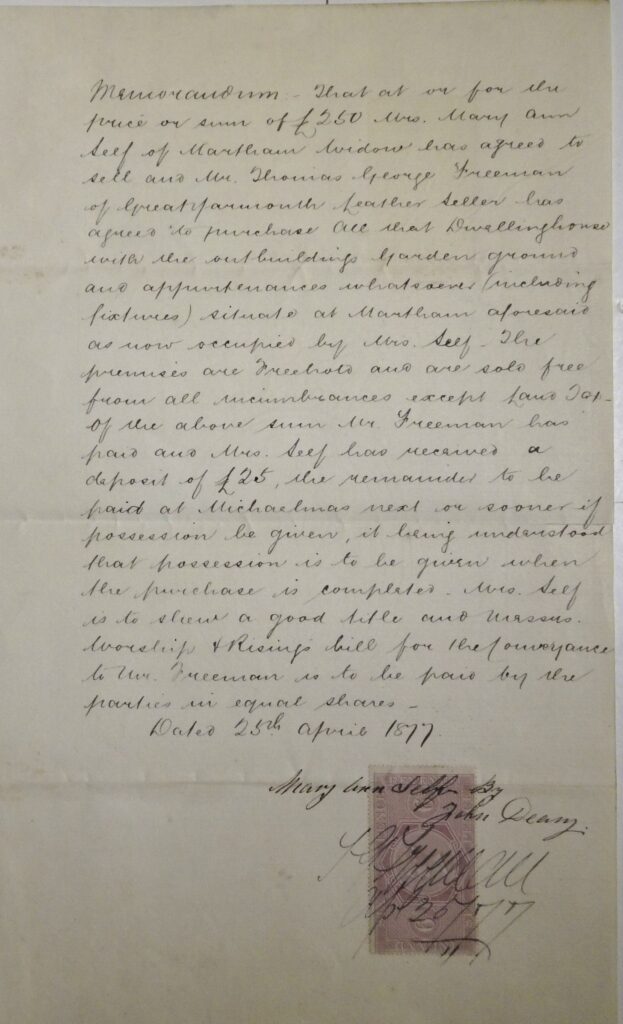
Appendix A9 – 1881 census form with Loxwood Villa highlighted in green and The Wilderness highlighted in pink.
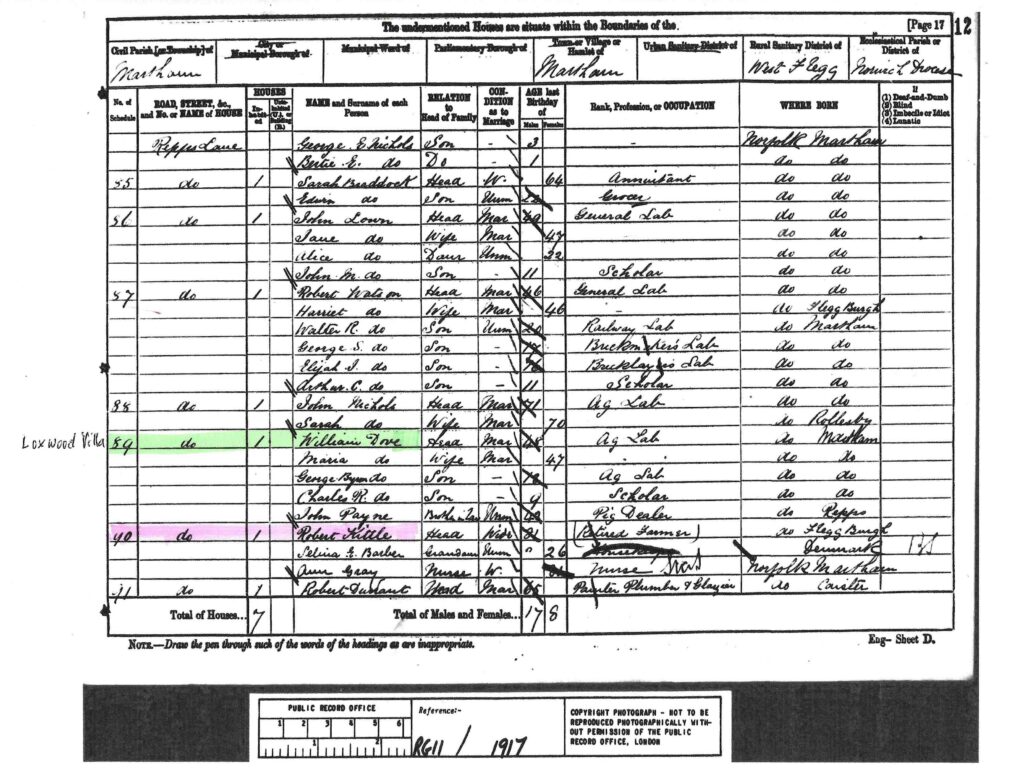
Appendix A10 – 1891 census return for Loxwood Villa when the Tooke family rented the house.
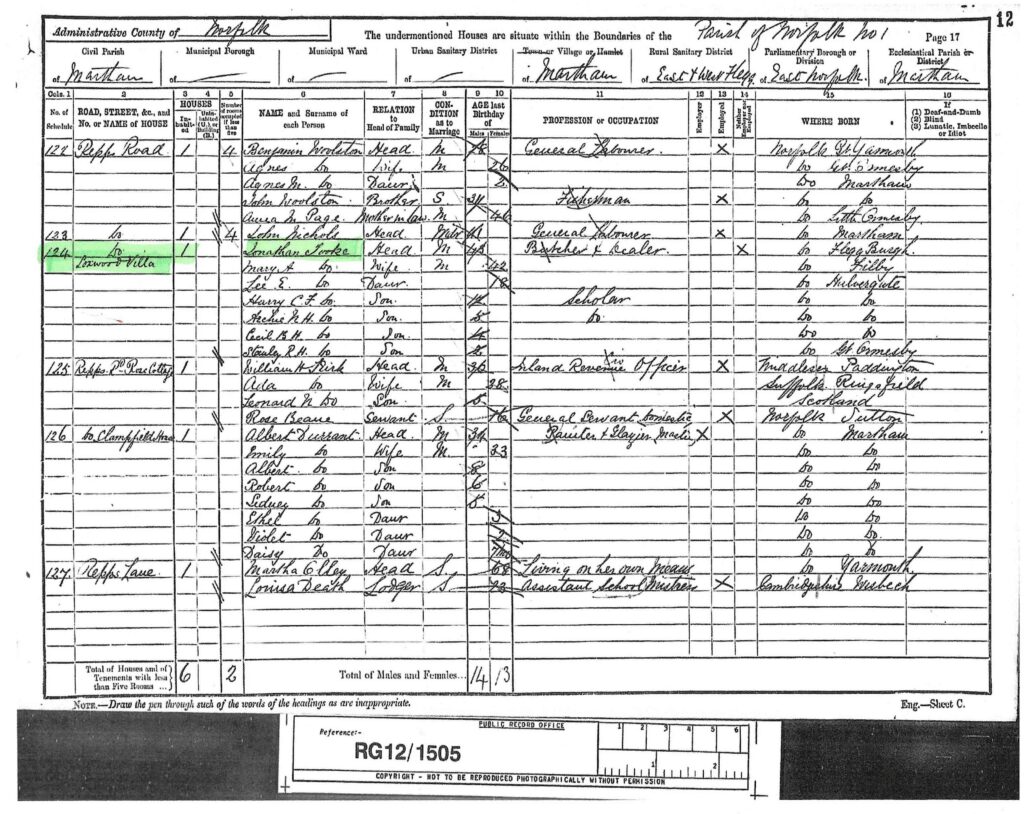
Appendix A11 – Extract of an article in the Norfolk Weekly Standard reporting on quarterly society change of addresses up to 29th September 1902 (published on 18th October 1902).
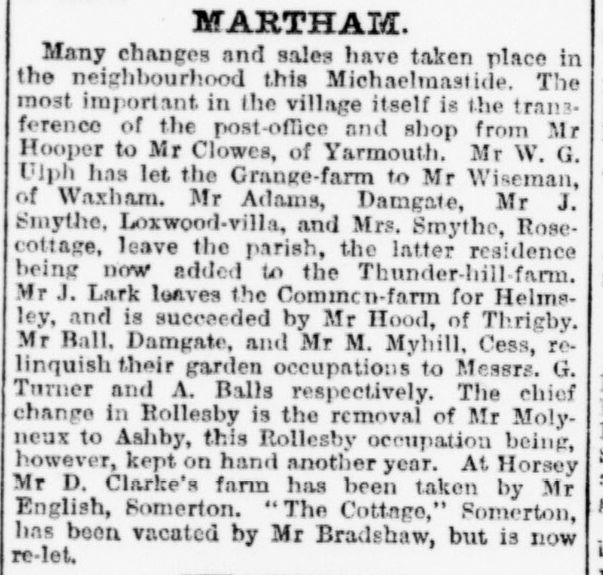
Appendix A12 – Report in the Eastern Daily Press dated 16th August 1902 about the local celebrations for the Coronation of Edward VII.
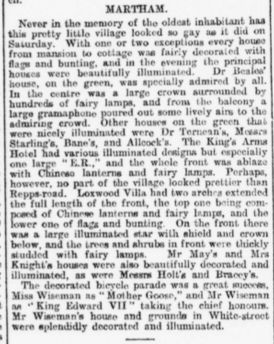
Appendix A14 – Conveyance from Phoebe Eleanor Alcock (nee Palgrave) to Cicely Eva Ann Tyson dated 7th January 1976.
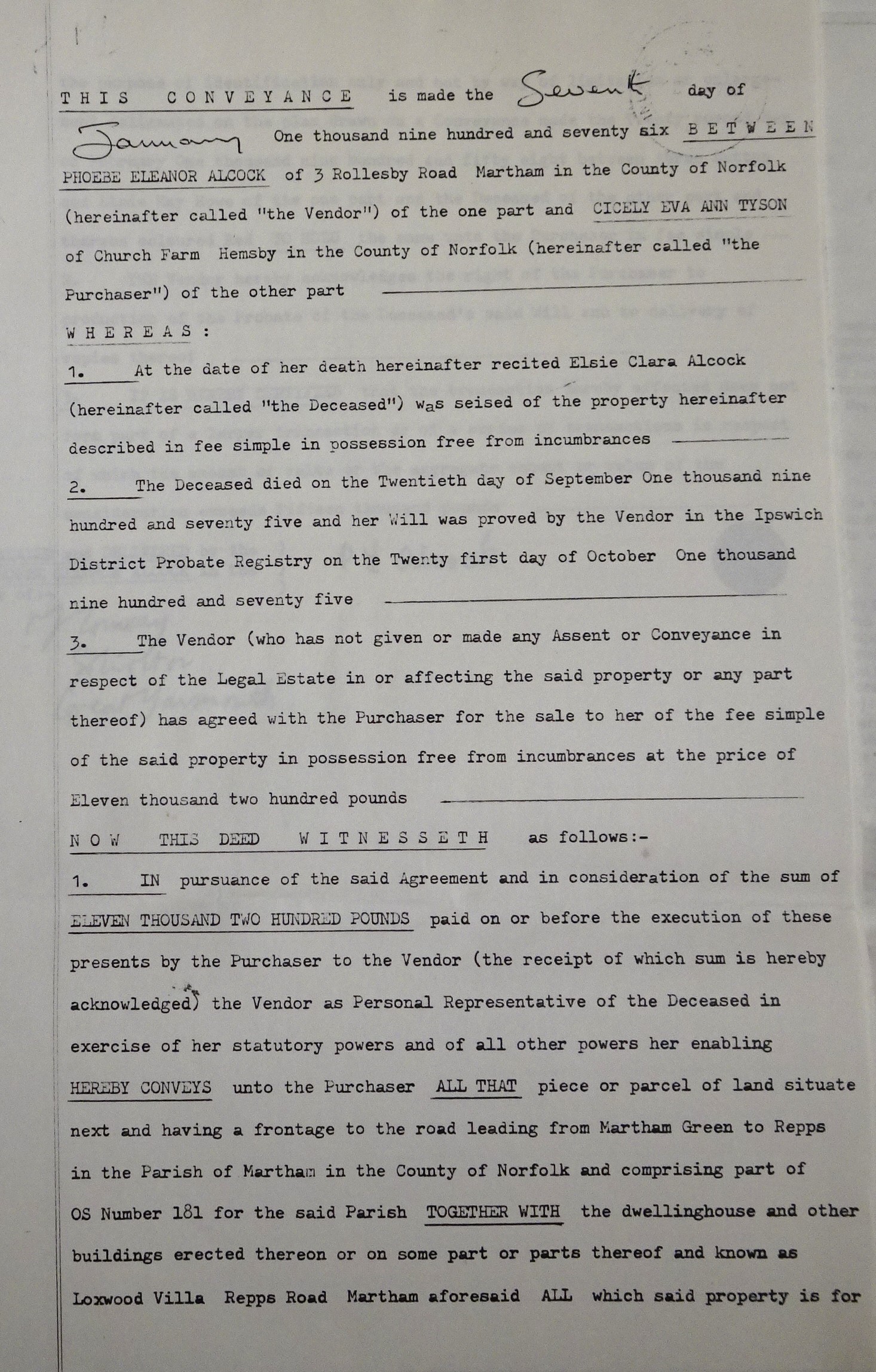
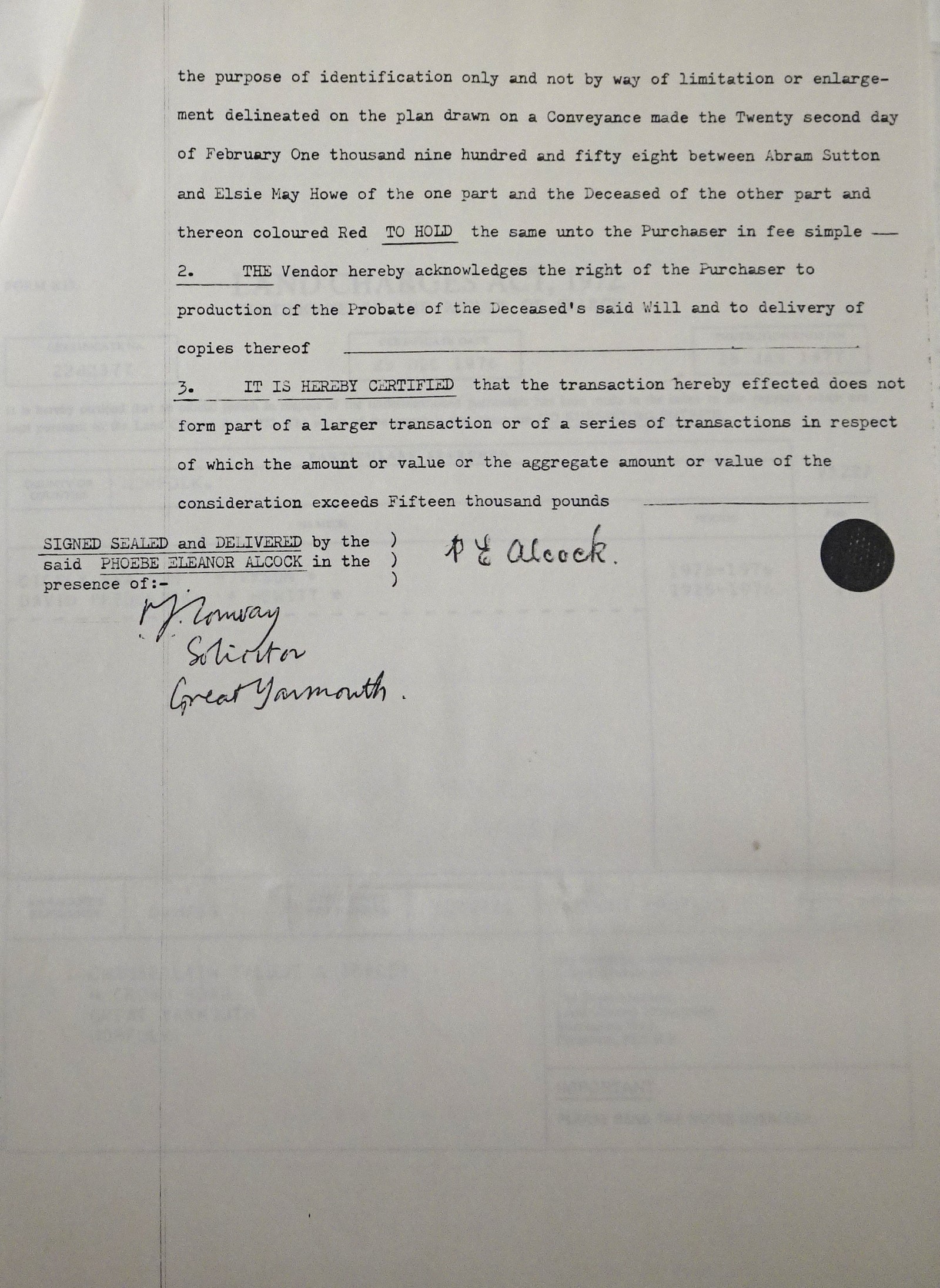
Appendix A15 – Conveyance from Cicely Eva Ann Tyson to David Frederick Hewitt dated 18th January 1977.
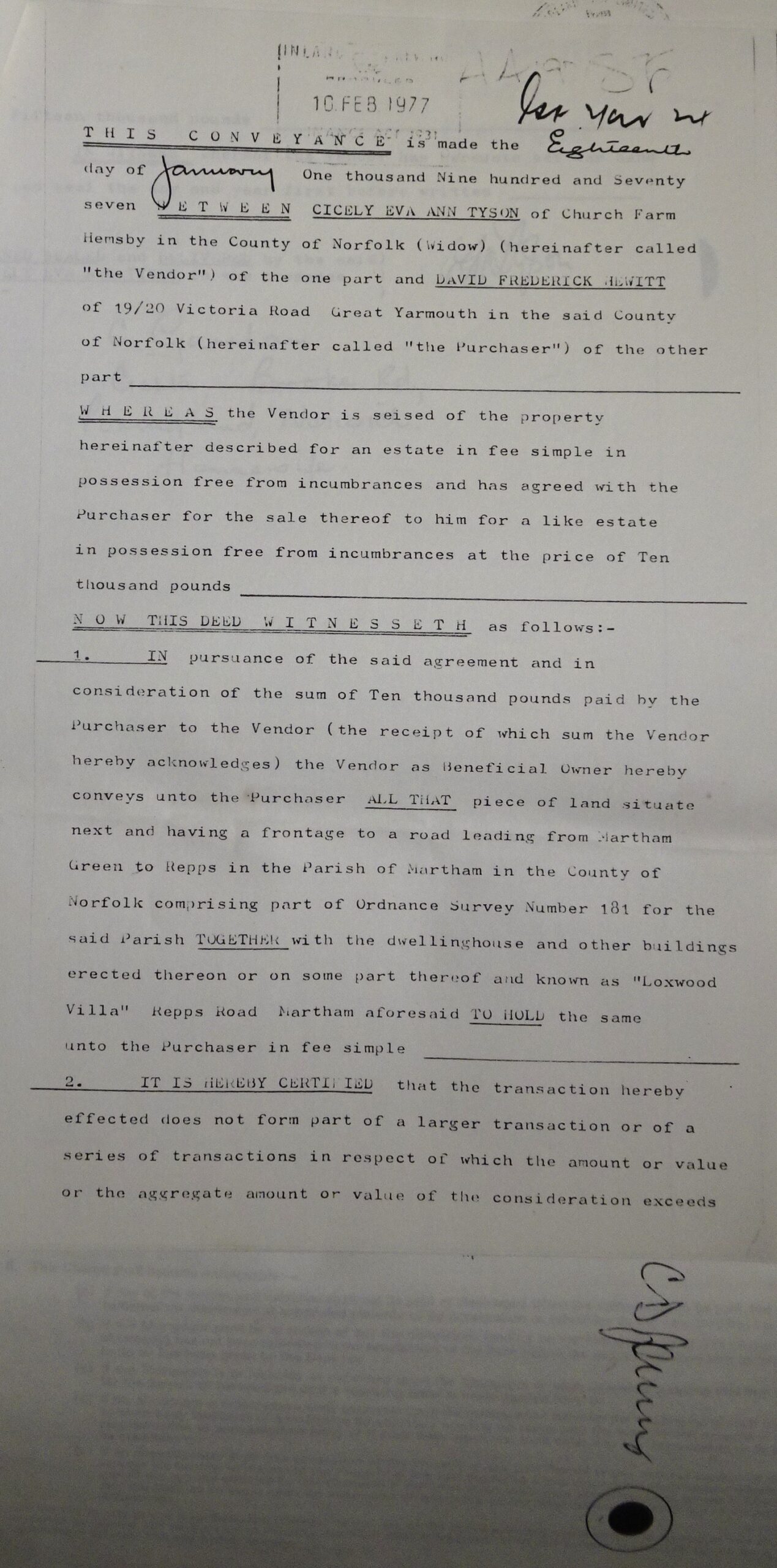
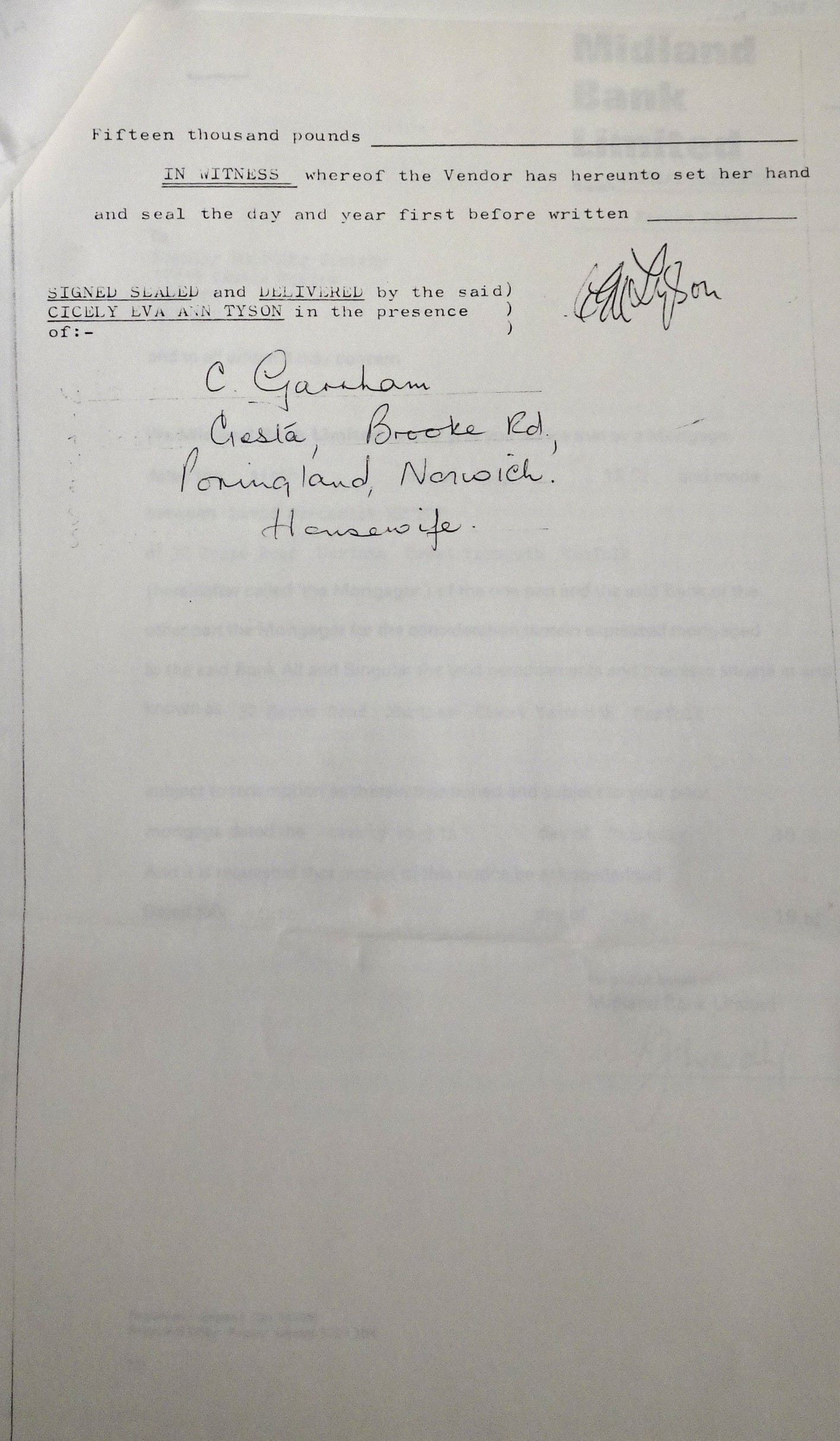
Appendix A16 – Conveyance from David Frederick Hewitt to Gerald & Beryl Desborough dated 26th November 1982.
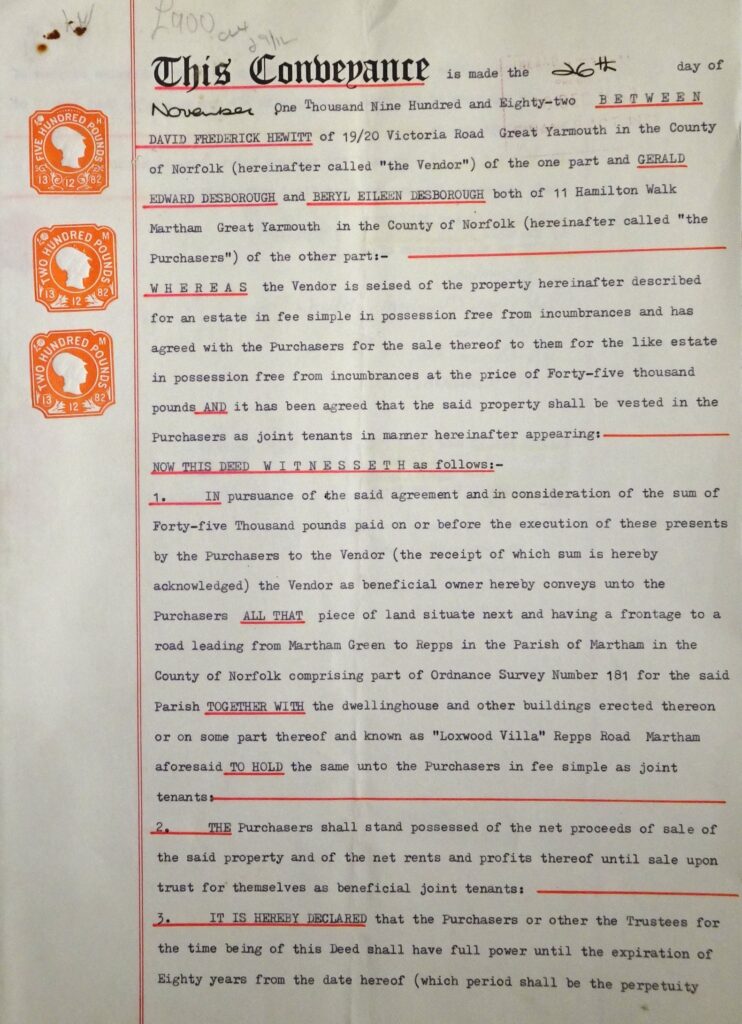
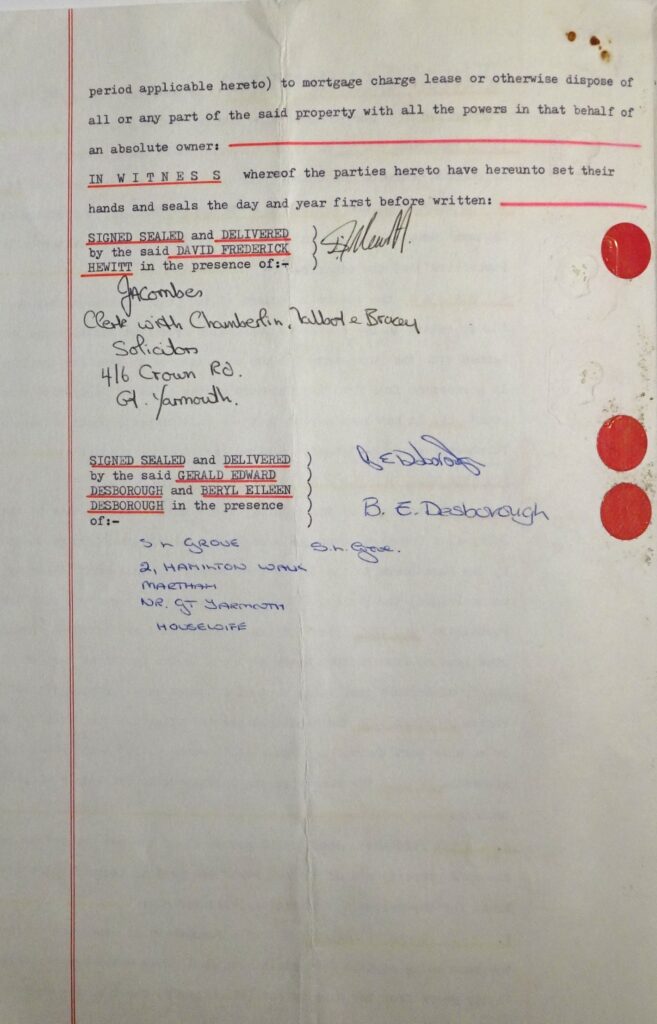
Appendix A17- Conveyance from Gerald & Beryl Desborough to A.S. Jacks Ltd (Alan Steward-Jacks) dated 16th August 1991.
